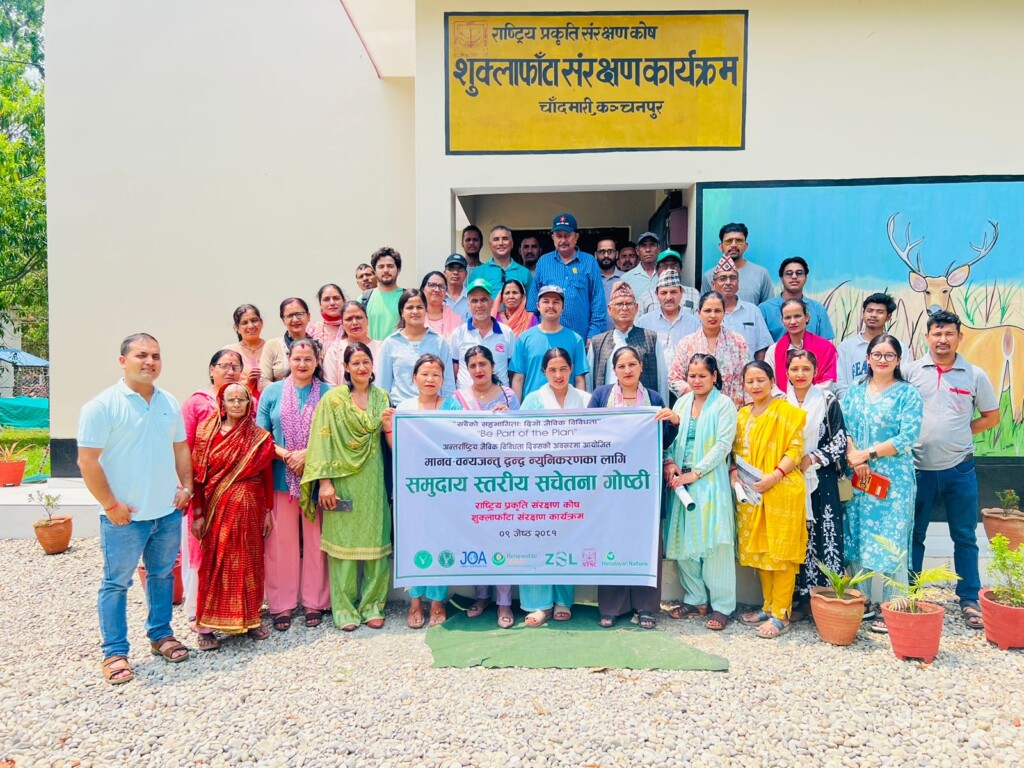


Connecting Communities and Ecosystems in Shuklaphanta National Park (ShNP)
Location
Shuklaphanta National Park and Buffer Zone, western Nepal
Project Dates
1 October 2023 – 31 March 2027
Technology
Solar-powered water pumping, solar-powered cold storage, solar-powered food processing (dryer, mill), bag bio digesters, solar-powered disaster risk reduction system, solar-powered lamp posts, E-cookstoves, solar electrification of homestays and Rangers’ Posts
Project Reach
7,036 direct beneficiaries
1,911 House Holds reporting an increase in income attributable to project activities
1,338 House Holds reporting increased food security
2,755 individuals trained
100 predator-proof corrals constructed
30 bag bio-digesters installed
20 community-based groups directly supported to conserve and/or govern natural resource use
Project Partners
Zoological Society of London (ZSL)
National Trust for Nature Conservation (NTNC)
Himalayan Nature (HN)
Project Funders
Jersey Overseas Aid (JOA)
Target SDGs
1, 2, 7, 8, 13, 15
Overview
The CONNECT project goal is to increase the biodiversity and climate resilience of Suklaphanta National Park (ShNP) and sustainably improve buffer zone community livelihoods, underpinned by systemic improvement in the region’s capacity for integrated conservation and development. CONNECT will make a transformative, sustainable, and scalable contribution to conservation and livelihoods in the ShNP, Nepal and beyond.
CONNECT’s three mutually reinforcing outcomes – improved conservation approaches, enhanced livelihoods underpinned by a strengthened market system and interdisciplinary coordination and knowledge generation – translate into positive and sustainable conservation and multi-dimensional poverty alleviation. CONNECT is implemented by adopting a market systems development approach
Results Framework
Outcome One: ShNP and buffer zone management actors from five municipalities are more effectively implementing sustainable, climate-resilient conservation strategies.
Outcome Two: 1,338 buffer zone households achieve increased sustainable income and security within a strengthened market system.
Outcome Three: The Park Authority, five local and one provincial government, are implementing improved interventions underpinned by current research into green development, and best practice green infrastructure guidelines.
Intervention packages:
Facilitate innovative research and collaborative working between development and conservation actors. (Contributes to outcome three, and underpins the sustainability of outcomes one and two)
Build Park and buffer zone capacity to conserve threatened Protected Area habitats and Community Forests (Contributes to outcome one)
Promote affordable Renewable Energy Technology (RET) packages and increase solar-powered water access in targeted buffer zone communities and the Protected Area (Contributes to outcomes one and two)
Improve the buffer zone economy by promoting ShNP as a tourist destination (Contributes to outcome two and indirectly to outcome one)
Enhance livestock management, including aquaculture, goat rearing, and diversification into profitable dairy farming by-products (Contributes to outcomes one and two)
Market system strengthening for identified agricultural products (inputs, supporting services and market access) for buffer zone suitable (repellent to wildlife) agricultural products (Contributes to outcome two)
Promote and make available clean technologies for improved post-harvest management by communities in the buffer zone (cooking, processing and cold storage) (Contributes to outcomes one and two)
Reduce Human Wildlife Conflict (HWC) through improved understanding and solar-powered disaster risk reduction (DRR) solutions (Contributes to outcomes one and two)